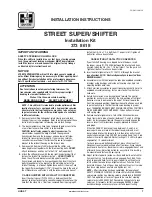
8-43
08
Recommended cold tire infla-
tion pressures
All tire pressures (including the spare)
should be checked when the tires are
cold. “Cold tires” means the vehicle
has not been driven for at least three
hours or driven less than 1.6 km (one
mile).
Warm tires normally exceed recom-
mended cold tire pressures by 28 to
41 kPa (4 to 6 psi). Do not release air
from warm tires to adjust the pres-
sure or the tires will be under-inflated.
For recommended inflation pressure,
refer to “Tire and Wheels” in chapter
2.
WARNING
Recommended pressures must be
maintained for the best ride, vehi-
cle handling, and minimum tire
wear.
Over-inflation or under-inflation
can reduce tire life, adversely af-
fect vehicle handling, and lead to
sudden tire failure that could re-
sult in loss of vehicle control re-
sulting in an accident.
Severe under-inflation can lead to
severe heat build-up, causing
blowouts, tread separation and
other tire failures that can result in
the loss of vehicle control result-
ing in an accident. This risk is
much higher on hot days and when
driving for long periods at high
speeds.
NOTICE
• Underinflation also results in ex-
cessive wear, poor handling and
reduced fuel economy. Wheel
deformation also is possible.
Keep your tire pressures at the
proper levels. If a tire frequently
needs refilling, we recommend
that the system be checked by
an authorized HYUNDAI dealer.
• Overinflation produces a harsh
ride, excessive wear at the cen-
ter of the tire tread, and a greater
possibility of damage from road
hazards.
Check tire inflation pressure
Check your tires, including the spare
tire, once a month or more.
How to check
Use a good quality tire pressure
gauge to check tire pressure. You
cannot tell if your tires are properly
inflated simply by looking at them.
Radial tires may look properly inflated
when they are under-inflated.
Remove the valve cap from the tire
valve stem. Press the tire gauge firm-
ly onto the valve to get a pressure
measurement. If the cold tire inflation
pressure matches the recommended
pressure on the tire and loading infor-
mation label, no further adjustment is
necessary. If the pressure is low, add
air until you reach the recommended
pressure. Make sure to put the valve
caps back on the valve stems.
Without the valve cap, dirt or mois-
ture could get into the valve core and
cause air leakage. If a valve cap is
missing, install a new one as soon as
possible.
















































